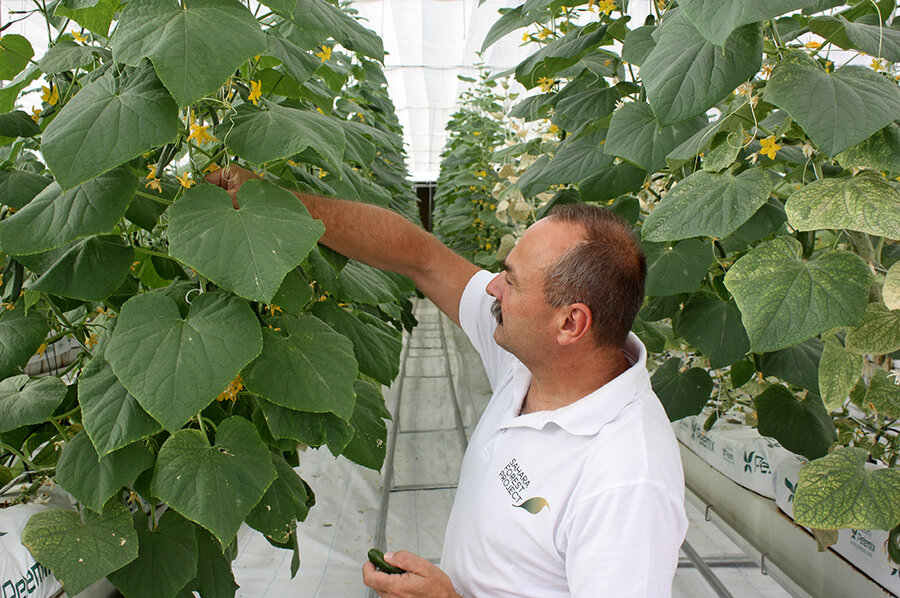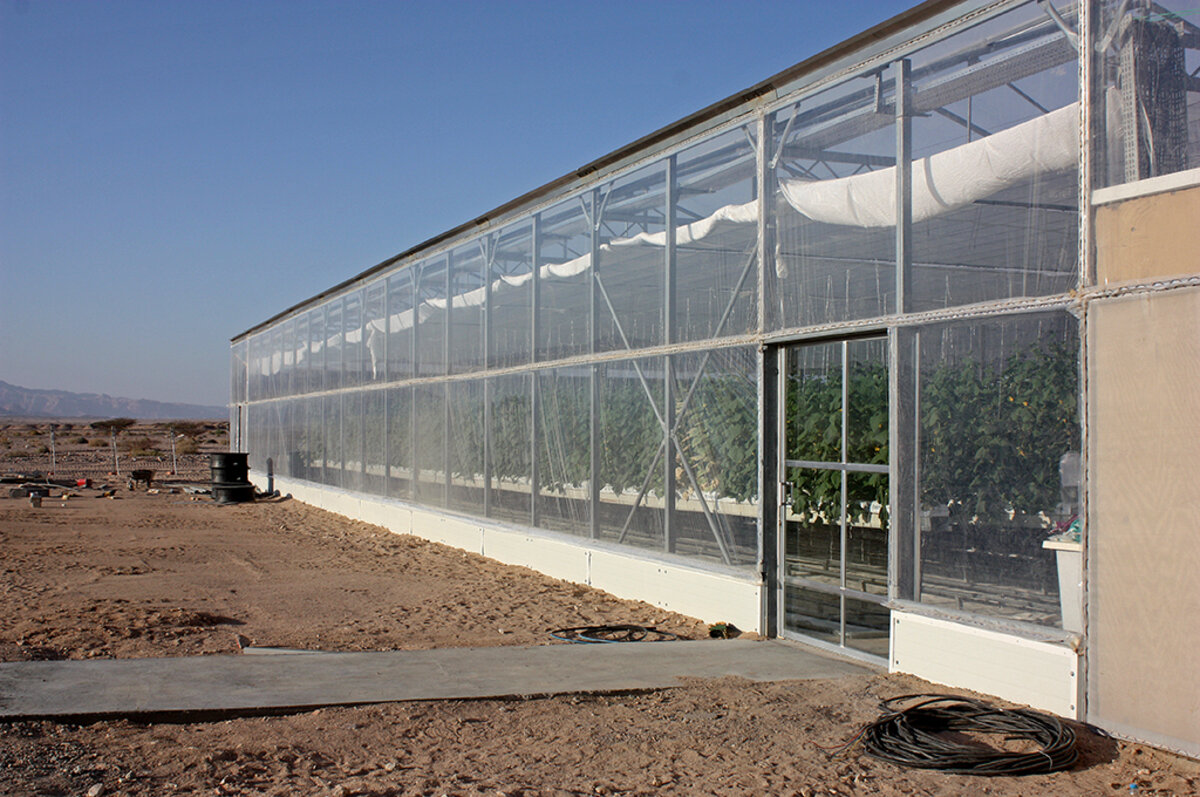Facing an even hotter, drier climate, Jordan testing desert agriculture
| Aqaba, Jordan
Hope in Jordan is taking the form of a cucumber in the desert.
It is not a mirage. Some say it is the future.
In the arid southern desert of Wadi Araba, where scorching temperatures and dust devils leave scant signs of life, a team of environmental engineers is working on a solution for countries on the front lines of climate change, facing drought and rising temperatures.
The engineers say they are designing a sustainable farm that uses solar power to desalinate seawater to grow crops in regions that have been arid for centuries, then uses the irrigation runoff to afforest barren lands and fend off desertification.
Similar ventures have had success in neighboring Israel, but it remains to be seen whether a fully sustainable farm can breathe life into the Jordanian desert and offer a model to a country that cannot spare a drop of its dwindling water resources.
Jordan has struggled for decades with water resources over-stressed by dramatic sudden population growth. Driven by waves of refugees, the population nearly doubled, from 5 million in 2004 to 9.5 million in 2015.
Jordan is currently ranked by the United Nations as the second-water-poorest country on the planet, behind only Bahrain, while increasing desertification due to over-grazing and improper irrigation techniques has reduced its grazable lands by 70 percent in the past three decades.
With the creeping effects of climate change, bringing ever-hotter summers and shorter rainy seasons in the winter, the future for Jordan’s environment is bleak.
In the increasingly drought-prone country, the enhanced evaporation of near-surface water due to decreased rainfall and hotter temperatures in recent years has rapidly increased the salinity of the soil, literally salting the earth. Jordan now has less than 1 percent forest cover and is more than 90 percent desert.
And the changes to come may prove to be even more dramatic.
According to a study published in August by leading researchers in the peer-review journal Science Advances, as soon as 2071 the average temperatures in Jordan could rise by as much as 4.5 Celsius or 8 degrees F. Droughts, the study suggests, could become twice as frequent and twice as long, and rainfall – a major source for Jordan’s dams and water resources – will likely decrease by 30 percent.
“Our results suggest that by the end of the century there will be a substantial increase in concurrent higher temperatures and lower rainfall,” Steven Gorelick, head of Stanford University’s Jordan Water Project and co-author of the Science Advances paper, says by email.
Sahara Forest Project
One potential solution lies in a patch of Jordanian desert that has not yielded crops for hundreds of years.
Originally conceived by environmentalists on the sidelines of the failed 2009 climate change conference in Copenhagen, the Sahara Forest Project was devised as a way to roll back the rapid desertification across Africa and the Middle East while addressing food and energy shortages.
“The food-energy-water nexus is very connected to climate change, and in order to address them, we believe you need to take an integrated approach to address all three,” says Joakim Hauge, Sahara Forest Project chief executive officer.
“This all came from a simple perception: we want to use what we have enough of.”
Supported by USAID, the European Union, and the Norwegian government, the commercial project combines solar power, seawater desalination, natural wind power, and computer-monitored controls to get the most out of each drop of water and to revitalize the barren soil.
Neighboring Israel has long worked to farm the arid lands of its Arava (Wadi Araba) and Negev deserts. Although in possession of more fresh water and energy resources than Jordan, it was facing a severe drought in the early and mid-2000s. After heavy investment in desalination, Israel’s production grew in a few short years to more than 130 billion gallons of potable water per year.
Jordan and Israel have pledged to jointly build a desalination plant on the shores of the Red Sea as part of a controversial $900-million project to lay a pipeline from the Red Sea to the contracting Dead Sea, which is below sea-level. But there has been little coordination between the countries’ researchers on the twin effects of climate change that both are fighting: drought and desertification. The Red Sea-Dead Sea project is years away, while timelines for the project on both the Jordanian and Israeli sides remain hazy.
The Sahara project aims to be a “synergy project” to the initiative, linking to the Red-Dead pipeline and using the excess brine and water released by the planned desalination plant for irrigation. While the 60-member international team who had input on the Sahara project did not include Israeli experts, project members say they are open to learn from the Israeli experience as they move forward with their own unique model: a farm that incorporates several technologies to run completely independently.
Self-sufficiency
Self-sufficiency is key for Jordan, which imports 96 percent of its energy needs and cannot afford the electricity or investments needed for large-scale projects.
In its initial test project in Qatar, the Sahara initiative yielded positive results, producing crops at the level of European commercial greenhouses with half the amount of water used in farming in Qatar. But project staff quickly zeroed in on Jordan due to its vulnerability to climate change and its location at the heart of the region’s water and environmental crises.
In a once-barren plot the size of four football fields near the Israeli-Jordanian border, 10 kilometers inland from the port of Aqaba, the Sahara project uses saltwater-cooled greenhouses and an advanced desalination system to produce crops without using a single drop of Jordan’s freshwater resources.
Using photovoltaic solar panels, the project takes in seawater and pushes it through a 6-inch-thick cardboard filter system at the greenhouse’s walls. Freshwater droplets form and evaporate on the other side, increasing humidity in the greenhouse and reducing water requirements for the crops.
Due to the site’s location in a valley surrounded on either side by mountains and hills, it receives constant wind, which is funneled into the greenhouse. The wind and humidity combined drop the temperature in the greenhouse by nearly 15 degrees C, from a baking 40 C (104 F.) to a cool 25 C (77 F.).
Such a drop can make or break a crop in Aqaba and the surrounding Wadi Araba desert, where temperatures reach 45 C in the summer.
Freshwater from the solar-powered, reverse-osmosis desalination system is then used to irrigate the crops. A computer-controlled system provides the crops with just the right amount of water and nutrients at timed intervals.
The second pillar of the project is in outdoor fields adjacent to the greenhouse. Here, run-off from the irrigation, up to 25 percent of the irrigated water, is used to grow crops and plants specifically suited to the Jordanian desert, such as vibrant pink Bougainvillea flower bushes, known locally as majnouna, and towering palm trees.
Over time, these fields return nutrients and moisture to the soil and act as a barrier against the increasing creep of desertification – stopping dust and sand in their tracks. Once the soil improves – within a couple years – Sahara researchers believe they can start cultivating outdoor crops.
Already, flowers and saplings are sprouting from what was once “pure, clean desert.”
Rows of deep green cucumber vines hang in the greenhouse, their fruits a few inches long and sweet and crisp – like the Mediterranean varieties that grow elsewhere in Jordan.
The launch site is projected to produce 130,000 kilograms (140 tons) of vegetables per year and more than 10,000 liters (2,600 gallons) of fresh water per day. Although the project has started with cucumbers as a test crop, it is exploring other potential produce such as tomatoes, eggplants, strawberries, or rhubarb.
Yet the Sahara project claims it has additional, secondary benefits other than crop yields and stopping desertification. The electricity produced by the solar panels, currently at 40 kilowatts competitive with commercial prices, could be sold back to the grid. Future larger farms would create more electricity for the grid.
No ‘silver bullet’
Project organizers admit that while the Sahara Forest Project could become a lifeline for countries such as Jordan and Tunisia, it cannot be a sole provider of food or be applied in all regions. Sahara requires a coastline nearby and sufficient sunshine to power its system.
“This is not a silver bullet that works in all arid areas,” says Mr. Hauge, “but it can work in low-lying arid areas” that can be provided seawater using minimum pumping or energy.
The project has started out small. Only weeks old, despite boasting bountiful cucumber crops, it has yet to be proven to be commercially viable year-round.
Currently, seawater is being trucked into the site, but project directors hope to build their own pipeline, or connect to the planned Red-Dead project in order to expand. The need for security coordination and permits in the Jordan-Israel border area is a sign that even the best-designed project may run into the limits of Middle East politics.
But Jordan itself has made the project a priority, with King Abdullah inaugurating the project personally last month, and his government endorsing the initiative. Sahara and its backers are looking to expand the Jordan site fivefold to 50 acres, with the potential to produce nearly 5,300 tons of crops per year.
The Sahara project is also pursuing similar sites in southern Tunisia and Australia.
While the outlook for vulnerable countries such as Jordan may seem bleak, experts hope to prove that the solution may already be at hand.
“Light, seawater, and land can produce food, water, and renewable energy,” says Hauge.
“All we have to do is integrate the technologies.”






